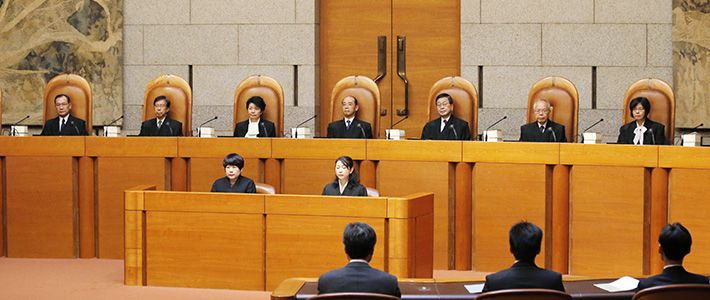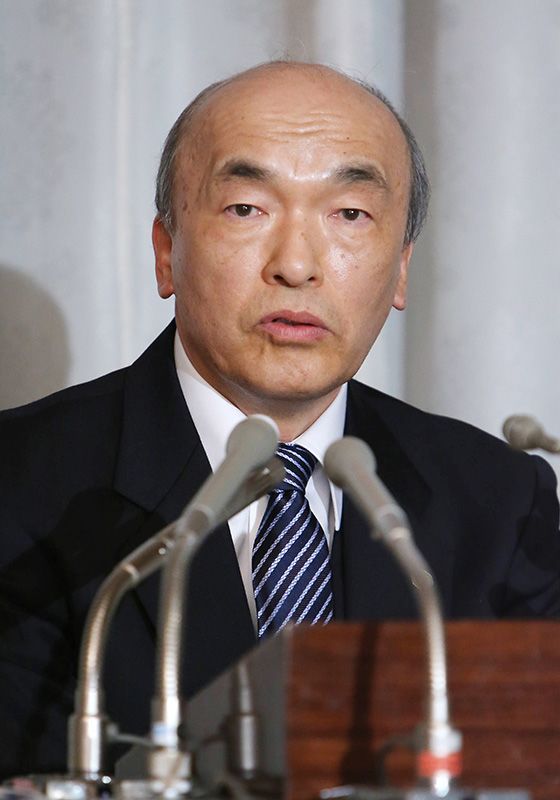
Second-Generation Chief Justice a First for the Supreme Court
Politics Society- English
- 日本語
- 简体字
- 繁體字
- Français
- Español
- العربية
- Русский
A Chief Justice with a Unique Background
 Newly appointed Supreme Court Chief Justice Terada Itsurō addresses reporters during his inaugural press conference, April 1, 2014. (© Jiji Press)
Newly appointed Supreme Court Chief Justice Terada Itsurō addresses reporters during his inaugural press conference, April 1, 2014. (© Jiji Press)
Terada Itsurō, 66, has been appointed as the eighteenth chief justice of Japan’s Supreme Court. If he remains on the bench until 70, the retirement age for justices, he will have four full years to set the tone of Japan’s judicial stance in the Terada court.
Terada comes from a line of justices, with both his grandfather and father having sat on the bench. His father, Terada Jirō, was the Supreme Court’s tenth chief justice, making Itsurō’s appointment the first time since the ratification of the Japanese Constitution in 1947 that a father and son have both held the top judiciary position.
The Supreme Court sits atop Japan’s three-tiered judicial system and comprises 15 justices, including the chief. The court is divided into three petty benches (shōhōtei) with five justices ruling on cases passed up from the lower courts. Rulings by the grand bench (daihōtei) involving all 15 justices are made in cases involving judgment of the constitutionality of a law, findings of unconstitutionality, and overturning of precedent set by earlier Supreme Court rulings. The grand bench also rules on other important cases the petty benches have found appropriate to refer. The chief justice serves as head of the court when the grand bench meets.
To become a Supreme Court justice, an appointee must be at least 40 years old and have “broad vision and extensive knowledge of law.” Passing the bar examination is not a prerequisite for appointment—former diplomats and other administrative officials commonly sit on the bench—but at least 10 members of the court must have experience as judges, public prosecutors, attorneys, or legal scholars (at the professor or associate-professor level). All justices over the last half century have been in their 60s, prompting a previous member of the bench to call the court a “gathering of stubborn old men.” Earlier chief justices heralded from the ranks of legal scholars, public prosecutors, and lawyers, but a streak of career judges has continued over the last 10 appointments.
Chief Justice Terada began his career on the bench. After less than 10 years in the courtroom, though, he moved to the Ministry of Justice. He spent the next 20 years as a government official, with his various postings taking him as far as the Japanese embassy in the Netherlands. While at the Justice Ministry, Terada served as director-general for the Judicial System Department and Civil Affairs Bureau, where he was involved in reforming the judicial system. There his expertise played a part in the drafting of legislation opening the way for participation by citizens as “lay judges” in criminal trials. Terada’s aptitude as a negotiator and a political consensus builder is well known; former chief justice Takesaki Hironobu lauded his successor, noting that Terada’s time away from the bench has made him an able public administrator.
Setting New Standards for Vote Disparity
I covered the court of Terada père as a legal affairs correspondent nearly 30 years ago. An issue that troubled the senior Terada during his tenure was the political implications of malapportionment.
At that time, House of Representatives elections were based on a multiseat system, with 3–5 seats allotted to each constituency. Population discrepancies among those electoral districts resulted in disparities in the relative value of a vote, though, and lawsuits to rectify this were soon working their way through the system. The first ruling by the high court to address malapportionment concerned the 1972 lower house election; the court ruled the vote discrepancy of 4.99:1 (with a vote in the least populous district wielding nearly five times the representative clout of a vote in the most populous district) was unconstitutional. At the same time, though, the court upheld the election results to avoid the instability that would result from a nullified election. The decision also stopped short of defining a constitutionally acceptable level of disparity.
The Diet subsequently amended the Public Offices Election Act, increasing the number of lower house seats in heavier populated urban areas to lower vote discrepancy to 2.9:1. But disparity continued to widen,driven by the unabated shift in population from rural areas to cities, and the ratio edged toward 4:1 in the 1980 general election. The senior Terada became chief justice just as the issue of vote disparity was coming before the Supreme Court.
In autumn 1983, the Terada court declared the 2.9:1 ratio constitutional, but ruled that the 1980 election had been held in a “state of unconstitutionality”—a statement that registers the court’s view of the situation as one to be addressed. In view of the considerable time and effort required to address the imbalance, the court refrained from declaring the results unconstitutional, instead expressing to the Diet its strong desire for “prompt action to rectify the situation.”
Critics, citing the principle of “one person, one vote,” disagreed with the court setting the benchmark at just under 3:1 instead of a more agreeable 2:1 and accused the judiciary of pandering to the Diet. Undoubtedly, the Terada court expected this decision to be an interim ruling, but the “3:1 standard” was to remain the de facto yardstick for the next quarter century.
The lower house electoral system was reformed into single-seat districts in 1994 with the goal of keeping disparity levels below the 2:1 mark. To ease the effects on less populated prefectures that lost seats, a “one extra seat” system was introduced, giving each of the 47 prefectures one seat from the 300 single-seat constituencies and allotting the remaining 253 seats in proportion to population. This still resulted in rural areas receiving a disproportionately larger number of seats, though, sending the disparity above 2:1.
The Diet has kept adjustments to disparities to a bare minimum, using the Terada court decision from the multiseat era to define the constitutional line for disparity at 3:1 in votes for House of Representatives seats and at 6:1 in House of Councillors contests. The high court is also culpable for this state of affairs, having allowed the Diet to remain delinquent in its duty to address malapportionment by repeatedly handing down rulings leaving the issue up to parliamentary discretion.
Change Under the Takesaki Court
The appointment of Chief Justice Takesaki Hironobu in 2008 changed the Supreme Court’s stance. In 2013, the Takesaki court ruled that elections for both the upper and lower houses had been held in a “state of unconstitutionality.”
The court cited the inequity of the “one extra seat” system as basis for ruling the 2009 lower house election (which had a vote disparity of 2.3:1) as unconstitutional; it then went on to declare that the deadline for addressing this issue had significantly passed. In its ruling on the 2010 upper house election (5:1), the court recommended revising the allotment of constituencies to better reflect current prefectural populations.
Backed by the strong stance of the Supreme Court, high courts around the country have since handed down a string of decisions declaring the 2012 lower house election (2.4:1) as being either unconstitutional or in a state of unconstitutionality. Two courts even went so far as to declare the elections invalid.
Attempts to reform how Diet seats are allotted failed to materialize in time for the 2012 contest. An electoral reform bill passed after the election, dubbed “plus 0, minus 5,” addressed disparity by reducing seats in five prefectures with low populations by one seat each. These moves failed to do away with the one extra seat system, though.
In November 2013 the grand bench delivered a much-anticipated judgment on the matter, ruling that while the election had indeed taken place in a state of unconstitutionality, the Diet’s reduction of seats “showed progress” and constituted “definite action.” Compared with the previous firm stance of the Takesaki court, this ruling seemed to sidestep a conclusive decision out of political diffidence. This leaves one wondering as to what occurred.
The return to power by Abe Shinzō in 2012 played no small part in this. The Abe administration, as it looks to reinterpret the constitution to allow for collective self-defense, has taken the unconventional step of appointing Yamamoto Tsuneyuki, previously director-general of the Cabinet Legislation Bureau, to the Supreme Court and naming former foreign diplomat Komatsu Ichirō as his successor. While the Cabinet Legislation Bureau has traditionally opposed reinterpreting the constitution, Komatsu has expressed a willingness to consider it. Abe has also moved to fill top positions at Japan’s quasi-national broadcaster NHK with appointees sympathetic to his views. The Supreme Court may have staked out a more timid position in the face of an administration so willing to bolster its political leverage with high-level appointments.
Touchstone Case Awaits New Court
Chef Justice Takesaki unexpectedly stepped down from the bench in March, four months prior to the end of his term, citing health reasons. There has been speculation, however, that his aim was to prevent interference by the cabinet in appointing a successor. Others speculate that Terada’s prominence in political circles gave the Kantei (the prime minister’s office) little reason to challenge the appointment.
A line of decisions by high courts across the nation in 2013 and 2014 have found the 2013 House of Councillors election unconstitutional or existing in a state of unconstitutionality. This will likely make vote malapportionment the first case on the docket for the new chief justice. Vote disparity between upper house districts is twice that for the lower house, and despite repeated warnings by the Supreme Court, the Diet is struggling to meet its promises to enact strict reform to remedy the situation before the next election.
Those familiar with both father and son say Terada fils comes to the bench with greater capacity and broader vision. He has developed an abundance of political associations from his years as a legal bureaucrat, though. One true test for the new chief justice will be how much distance he places between the bench and politics.
(Originally published in Japanese on April 16, 2014. Photo courtesy of Jiji Press)
constitution Ministry of Justice vote disparity Supreme Court judicial reform